
|
 |

|
 |
Saroja Vaidyanathan's son on her philosophy - Part 2 - Shveta Arora e-mail: arorashveta1806@gmail.com Photos courtesy: Ganesa Natyalaya February 26, 2024 How Saroja ji responded to the fear and lockdowns during Covid-19 She didn't have any fear of living or dying. But she had the depression of no vibration. "I want some dancing," she would say. If you come to Natyalaya, what you experience - it's not one person or two people dancing, there is a very positive vibration. I feel that during Covid, she missed the ghungroos, the sound, that beating on the floor. It is a physical vibration, apart from the mental vibes. And then the kids being there, laughing, this and that. It's a mela with all these kids there. 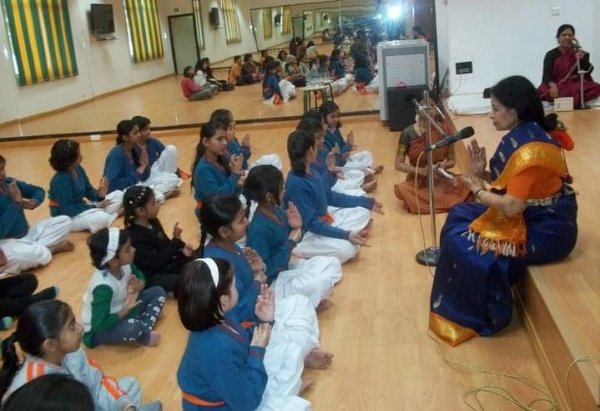 Taking class So for me, nowadays (when Rama and Sannidhi are travelling for performances), when everybody goes back by 6.30 or 7pm, it's terrible when I'm all alone in the house, a place which is not like that, normally. That's one thing that Covid hurt. Could that have been one reason she got a heart attack? I don't think so. Because she got it in the end of phase one, about two months after Sunil Kothari ji passed away. But somewhere in her mind, she felt, I don't have people around. If she had a choreography in mind, she wanted to see the girls dancing. She would want to picturize it. That was paused / postponed. That implementing arm went. Saroja Vaidyanathan's approach to business and teaching It is true that the government has many schemes for funding the arts. I'm not sure how we entered it, but we were getting grants, teachers' grants. When you maintain a school with no building and everything, there is no overhead. There's simply a room. You're collecting fees, you're getting grants, and that's it. But when you have a building, it's a constant source of maintenance. The people involved, employees, electricity, water, maintenance... something is always going wrong (and needs fixing), building tax, ground tax. So we needed support. The government did give us support, and we are very thankful for that. The government also made it a point that they were auditing us. They were watching what we were doing. We had to prove that we were doing something constructive there. That was not a challenge. The grant which was coming in had to be utilized. That was also not a challenge. We are doing that effectively. Also, we would do the social service of teaching students for free. We would not hesitate in reducing the fee for somebody who said, 'My mother is a single mother' etc. Some people would say, 'We are not having any source of income which is steady because of Covid-19.' So we said, 'Okay, come anyway.' 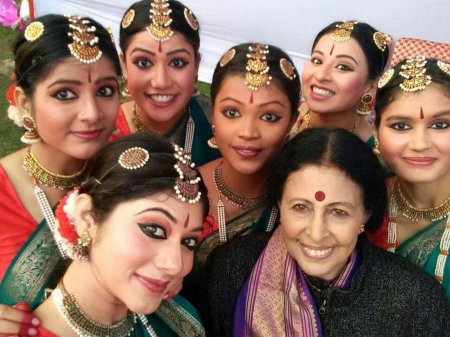 With her students The idea was never to stop someone's education. I would feel that anything free is the problem. I didn't want it to be free. But there were times that I found some students left, and when I would tell that to my mother, she would only say one thing: "What is the rationale for decision you took to charge that person something? See what has happened. That person had to leave." So there were times when we discussed this. I held my ground, but then I had to relent and I started understanding what she was saying. She meant, "Somebody else who can pay has given you the money. It's not like our place has no money - no profit, no loss is not our case. We make some profits sometimes, maybe some big amount, some small amount, nothing great. But then what is that for? That is to subsidize this." Her psychology of education was totally different. If you are able to get another hundred students who are underprivileged, bring them in. That was how she kept sanitizing my corporate mind. I was an engineer. And I was working with very clear plans of how I wanted to increase my business. I was with Hitachi for 30 years. And she changed it within that time, during our discussions, as to how we need to run an organization. Everything is not corporate. We are to do it differently. I think she had a great vision and made me realize that we have to make things count for each other; it can't all be for myself. That's when I started thinking that everything that she's done needs to be rehashed. Her music - maybe we should call Sudha Raghuraman and somebody else and get that music done again for her because she had other ideas now. And she had made almost 26 to 30 dance dramas on various themes. She actually roped in my father as Shankaracharya in one of these dance dramas! He had retired. He said, "I am an IAS officer! There's no way I am getting on the stage!" But she got him to and he performed so well that some people actually came and prostrated themselves in front of him and took blessings, so realistic was his acting! 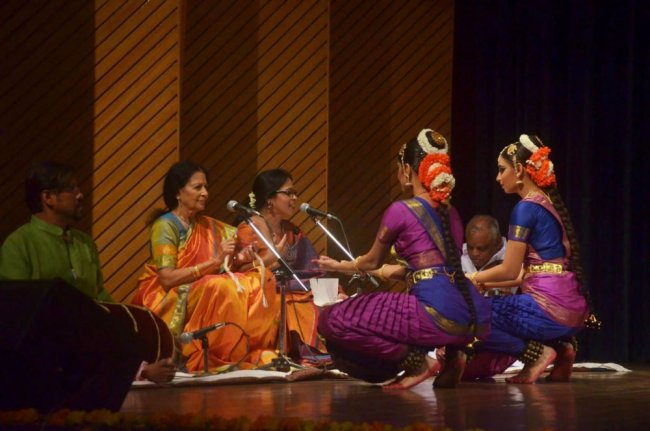 Conducting a recital I was very intensely handling the administrations and one day she was watching me. She said, "I have choreographed 'Namami Gange' and I want you there." I said, "What will I do there? I can be a sutradhar, if you think my voice or my delivery is OK." She said, "You're going to come in as Mr Modi because it's his brainchild (the central government's Namami Gange project to clean and rejuvenate the Ganga)." Namami Gange is beautifully done. It starts with the mythology, connecting it and bringing it to the contemporary times and telling us why we should worship rivers. They are the source of life and we treat them like canals, drains. That was the message she wanted to send out. And when I questioned it, she said, he has a vision of Ganga. Look at the way Thames is in London. Look at the Seine in Paris. She had travelled to a lot of these places and in every place she saw rivers like this, like the Pontiac River in Washington, D.C, she said, 'Why are those rivers so neat and clean?' We were posted in Japan for some time, Rama, the kids and I. At that time, my father passed away. That was in 1998. So we took my mother there. She saw the rivers in Japan. Water was a very important aspect of life. So she said, "Why is the Ganga not made like that? It has to be swachh, it has to be beautifully banked. We must encash that legacy we have." I had my hesitations about appearing on stage in the beginning, but I did. I am the only person who's featured in every Namami Gange recital - girls in the group would keep changing for exams or other reasons, but Mr. Modi was always there! It was one of Natyalaya's good productions. She also took it to Hungary and Poland under the Danube-Ganga collaboration; ICCR had sent her. His involvement with Ganesa Natyalaya I must say that the entire Natyalaya is the single-handed job of my mother. After marriage, of course, Rama has been there and my mother has felt her support in this thing. But everything is her dream, her vision. And I don't think I contributed anything more than moral support. Me being the only male member in the family (present in the city), my being there was important for any building. People around see I am there to keep a notional sense of support and authority. But that's the only support I gave till the final stages, when she really needed me. So it was before Covid-19, when I retired, that I started to get involved with Natyalaya work. I just want to chill and relax for a few months before I took up the next assignment. But Covid struck and the lockdown happened in March end. So I set it up in the whole of 2020 - a lot of platforms had to be changed, even bill payments etc., which we were not being able to do. We kept getting reminders on the phone, but there was no way of paying. By the end of 2020, everything was set up and we were nicely going ahead, and then Saroja ji got a heart attack in January of 2021, when the first wave had ended. She underwent an operation and came back home. And then the second wave started. The second wave in April '21 was disastrous. Then again, towards the end of the second phase, she had a little ill health and needed a pacemaker. That was the time when she really felt that it was good to have me around her. 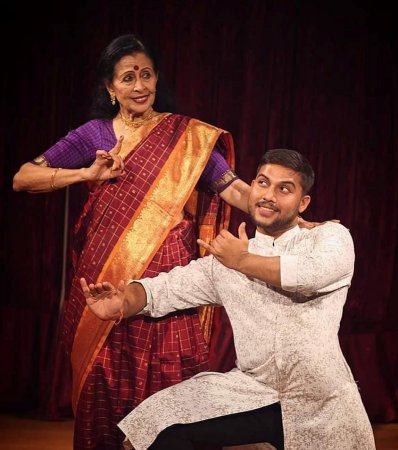 With student Vinay Tiwari Also, I set up some different kind of targets. We had about 75 to 80 students; in Covid times, it dropped to 50%. It didn't make sense for us to operate like that. So I said, let's have a target. We should go up to 150 and reach something like 200 students or so, because that would be the break-even for us to take care of a lot of expenses. And ever since then, we have been increasing the number of students. She has done over 300 arangetrams. Arangetrams are important for two reasons. One is that the students then become professionally capable - it is certified - that they have done that course. Secondly, it gives them the ability to become teachers. Many of our teachers are our students. Two years after their arangetram, they start teaching. 35 of our students have set up schools worldwide in affiliation with Ganesa Natyalaya. She's got currently maybe 2500, 3000 students who are actually practising this around the world. Illness Saroja ji was last on the stage in February 2023, for the Sangeet Natak Akademi, the Ratna Sadasyata. That was formally her last, but she also performed in Chandigarh in April 2023. In the beginning of June was when she complained, and I think her pain was alleviated after a course of antibiotics. We kept going through tests. Till that point, I was in denial, because there are false positives. Saroja ji looked hale and hearty. She was upbeat, wanting to move. So I was thinking these are wrong reports. But it seemed to have spread all over, including the brain. It was a lymphoma, cancer. After that I was with her 24/7. Even her breathing her last was literally in my arms. We were in the hospital for about 10 weeks, and somehow it occurred to me that maybe if I bring her back home, the vibration of the house, of the Natyalaya... maybe something works. And also, I kept telling myself that nature cannot be that cruel. The thing is, 2024 is our 50th year of the Natyalaya. How can she be cheated of that? She was only asking for a few months. I never believed it could end like that. But it did when it did. She achieved everything - she saw her great-grandchildren. My brother in the US has a son and he's got three kids. So she had 3 great-grandkids from there and one great-grandchild from my side. She got awards, she got a school, and she got the security of Rama. She knows that her efforts will continue now. Absolutely no regrets, except for her passing away months before the Natyalaya's 50th year. In 2024, we are having a year-long celebration for the 50th year. It's a golden jubilee and we are calling it Swarna Saroja: Swarna for the golden and Saroja. We could not have stood like this if we were not supported by Odissi, by Kathak, by folk dances. No art is standing by itself. And that inclusivity brought her so much bonhomie with all her colleagues. She always, readily, said, "I have a platform. You come to Delhi, you perform in Natyalaya. I have 100 students, who have got 200 parents. So we can muster a fair turnout. And I will introduce you to people in ICCR and Ministry of Culture, etc." This is a very good, human side of hers that endeared her to everybody. I don't know of a single person who has anything negative to say about her. And I've never seen her say anything negative - not just about human beings, but about anything. Maybe I'm just happy to have been her son. When he realized his mother had become a public persona My father passed away in 1998. By then, she had achieved a lot - the building had been launched in 1987 and all these things were happening, but she was doing all this with my father's support. Somewhere, I feel that she gave him prime importance in her life. When my father passed away, it was a time when I felt she would need me. I realized that I was wrong. She didn't need me. I felt important that she needed me. But she was somebody of her own standing, and I saw that gradually. That's when I started wanting to protect her; I realized she didn't need the protection. She was a king in her own place, an empress of her building, of her Natyalaya. She was an empress in the hearts of so many. This came after my father passed away. In 2003, I think, she got the Padma Shri, so that only added to my confidence. Then she got the Sangeet Natak Akademi, Padma Bhushan, Kalaimamani, a lot of these awards kept coming. After some time, I had already accepted that she is being celebrated not for any reason other than the fact that she has something, something different.  Receiving Padma Bhushan But inside the house? We had our own skirmishes. I would argue with her, I would ask her about the finances and things. She would say, "You should sit down sometime - sitting outside and then talking like this is not good." She ticked me off. Then I realized that's correct. I cannot be someone who is working in Hitachi and suddenly, over a dinner, I'm pointing fingers saying, "It shouldn't be this way, it shouldn't be that way." She would say, "Explain why it should be done your way." She spent a good 25 years without my father, and I don't think I've ever seen her droop. It's only been up, up, up. She's written books you may be aware of. She composed music, she has choreographed. Her mind was always working on many things... a shloka and sending it across to the Sanskrit scholar, Tamil poems of the trio... She would constantly be at work. Rama and Dakshina as successors and dance legacy One thing she would always say, "I dance the way I dance, Rama dances the way she dances, but Dakshina is neither of us. She dances her way. It's a very fine difference. I'm not saying that structurally it's very different, but she has her own way of emoting." She was always very keen on the lineage, to maintain and take it forward. "We need to do something to consolidate it," she kept saying, "Why do you want to get the complicated stuff? Make it simple." 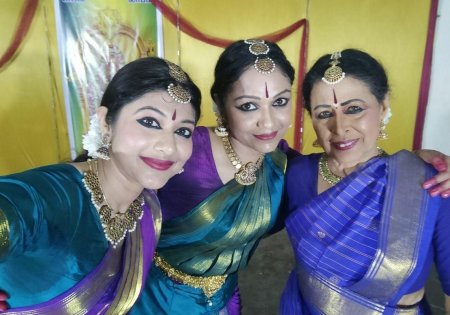 Dakshina, Rama, Saroja Even Bharatanatyam - it was codified by Rukmini Devi Arundale. Codification at that time was a little stricter; with time, you started exploring, pushing boundaries. You know, there are many things that people do today which are not traditionally part of that codification. And the younger generation is like that. Try boxing them up - you can't. I think that is very important for all the students. We teach them, but we also let them explore. In Delhi, there are close to about 6 students of Amma - I call her Guruji now because everybody calls her Guruji -who are running classes, but their students come periodically to Natyalaya to practise and to show Guruji. There is that bonding that you have to create. You can't think that they are competition. And sometimes, when we have two or three performances clashing at the same time, we don't have as many students to perform in them all, so students from there chip in. So there's a lot of collaboration happening within Natyalaya and its schools. This only happens when you let the kids be. They follow their dreams, do it their way. I think she really created that. She said, many times students come to her with their problems. Then I realized she is also playing a guide to their psyche. Some of them have doubts - ma'am, is it OK really if I dance, what will I have in the future? Can I earn enough? Can I find the right boy? What if I become too confident? Perhaps my benchmarks become so high that there is nobody around. Or some of them may have a break-up. These are some of the problems that these girls and boys brought to her. I've spoken about achievements in terms of the awards she's got, the Natyalaya she's set up, the schools her students have started, her collaborative spirit among all artistes. She choreographed and put up big shows like for the Queen's Baton (2009); the segment had about 250 Bharatanatyam dancers. Then she also presented a performance at the World Culture Festival by Sri Sri Ravi Shankar's Art of Living Foundation at the Yamuna banks in 2016, where she had 1,700 people. And to coordinate and to make sure that they danced together to the same steps - first you get the 1,700 people together - these were very painstaking, large projects and I think she did it with complete Úlan, never felt the stress, never brought it home in any way. Then there's another one that she was very keen on - non-stop Bharatanatyam dance marathon (at Ganesa Natyalaya from 10am on 23 September 2017 to 1.30pm on 24 September, awarded the record-breaking certificate by the Asia Book of Records and the India Book of Records for the longest (27 hour 30 minutes) Bharatanatyam Dance Marathon Relay). Today Natyalaya holds the record, the India record as well as the Asia record. But what is this? Actually, it was 295 artistes from all over the world who volunteered to come for this, as Amma had sent the invitation. They all came together and one after the other, they were slotted to perform over the night. Of these, about 25 dancers were overseas. So that was again one of those classic things that she wanted to do and she implemented it. She loved to push boundaries in terms of challenges. There's nothing that she would stop short of. She was very, very clearly focused. And she wouldn't give a choice. She would say, "You have to participate in this." If you are a dancer, and you have appeared on her radar, there was no going back. She'd make sure that you are participating ... she was very affectionately pushy. She was one of those people who loved ideas, loved implementing them. Many of us are ideators, but not doers. When you go to gym and see someone who has six-pack abs, it means somebody's slogged a lot for it. When you see somebody who's achieved even the six-pack - or achieved what my mother has achieved - you have to respect it. It hasn't come easy and it never comes easy. RAMA VAIDYANATHAN Saroja ji's significance in her dance journey She started teaching me and she shared the whole repertoire that she learnt from her gurus. That was very good for me because I already had a repertoire that I had learnt from my guru, Yamini Krishnamurti. But to learn a whole new repertoire, and several items in the repertoire, from a completely different dance style was very interesting for me, so I was able to amalgamate the two and then create my own style. She was a huge contributor to my style. Being Saroja ji's successor Right from the beginning, she put it into my head that "After me, you have to take care of Ganesa Natyalaya." And actually, I never, ever thought a day will come when she will be gone and I will have to take care of Natyalaya. It's only now it has hit me. She was preparing me... watching her in various situations, watching her teach and choreograph and everything. For 36 years, I have been with her. That's a long time to learn everything about her. So she kept saying it for past few years. And finally it has happened. Unfortunately, she has left us. It is more like on the job training (rather than teaching me directly how to head the Natyalaya). I saw how she interacted and how she behaved and all of that. She knew that I was watching, was experiencing, she did not say, "Look, I'm teaching you." It happened very organically. It was a lifetime of learning. Initial years Initially, when I got married, in all her dance dramas I was the main character. And it was very interesting because she was teaching me the repertoire. She didn't have to teach me how to dance, she had to teach me the repertoire. As I said, it was interesting to be exposed to a completely different repertoire, different style, different type of dance compositions. It really broadened my vista of Bharatanatyam. And she was very, very patient and sweet. She's never been strict with me either as a teacher or as a mother-in-law. She's always given me so much freedom, space to grow in the way I want to grow. She never stopped me from experimenting with anything, doing it and performing. She was warm and welcoming. And the fact that I was married to her son - she gave me so much of love. 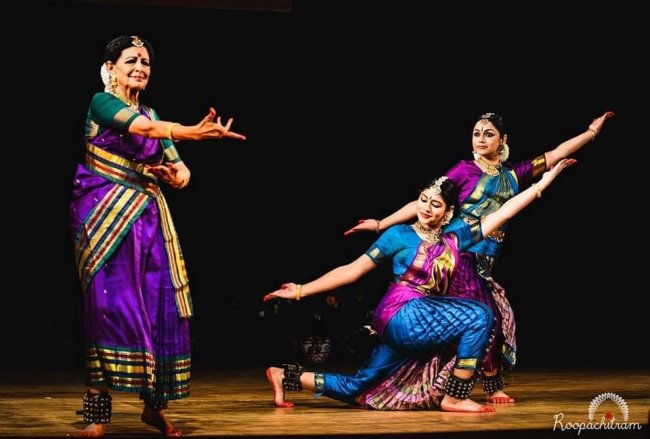 Saroja performing with Rama and Dakshina Last clip of Saroja ji from the hospital There was no music; she was just in her own mind. That music, which I shared of M.S. Subbulakshmi, was added later externally, but otherwise it was the hospital sounds - the monitoring machine and other things in the hospital. She was just in her mind, thinking of Nagendra Haraya, because from her actions I knew she was doing Nagendra Haraya. And so, the video was taken but then I did not want to post it. I actually posted it only after she went. It was with me for a long time. This is before she actually became absolutely still and uncommunicative. How dance helped through her illness I don't know about pain, but I know for sure that dance gave her a sense of calm. Even though she was in the hospital, with so many pokes and things, with so many doctors coming and going. But she had this connection with the supreme power, so... The last few months were very calm for her. Even though she was in pain, she took it and not even once did she scream. I feel if I'm able to be calm like this in my last days, it will be really good. 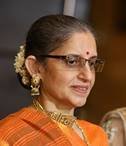 Shveta Arora is a dance-mad writer who chronicles classical dance events in Delhi (and also those online). In 2009, she started the blog Kala Upasana at delhiculturecomment.blogspot.com, where she began posting her own writing along with photographs clicked by Anoop Arora, her husband. She's been dancing all her life as a devotee, but resumed her formal training in Kathak in her 50s and has passed her fifth year Kathak exams. Post your comments Please provide your name and email id when you use the Anonymous / blog profiles to post a comment. All appropriate comments posted with name and email id in the blog will be featured in the site. |